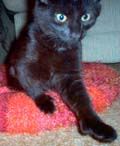I got a very nice inquiry about spinning llama fiber from someone who was fortunate enough to come across a bunch of lovely llama roving. I myself am only a beginning spinner. I learned on a drop spindle about 18 months ago but haven't yet spun llama on a drop spindle.
I do enjoy spinning llama on the wheel, both mixed with wool (I had some roving made from Llannie's fiber with 30% black lambswool last year) and just llama by itself. People say llama and alpaca work best for spinning (and knitting) when blended with a small proportion of wool (at least 30%) because the camelid fibers themselves have a limited "memory" -- this can make them, I've read, a touch slippery, less elastic and possibly harder to work with.
I didn't have this experience with llama, but llama varies quite widely in the coarseness to fineness of fiber (even on the same animal), the amount of guard hair (which is straighter and longer, like human hair) a given fleece has, the staple length, and the amount of crimp (one llama may have very crimpy locks, another far less curly ones, then there are the suri that everyone is always raving about, etc.)
Our llamas don't have a lot of guard hair, mostly it's on the belly and legs, but it is quite coarse and easy to separate from the softer fiber (much like you might on a double-coated sheep like an Icelandic, but llama guard hair is really hard to spin or even felt; I haven't found any use for it and we discard it). If you have llama fiber that still has guard hair in it, you probably want to get rid of those coarse hairs or it's going to be (at least I found) difficult to spin and will produce hairy, prickly yarn.
I myself love spinning with llama. It's such a lovely, soft airy fiber and the fact that it's hollow makes it very light and warm. I think llama varies more widely in terms of micron count than alpaca, and that may be why people gravitate toward alpaca, but llama fiber definitely overlaps with alpaca in terms of softness and fineness. For comparison, the average human hair measures from anywhere from 60 to 100 microns. Alpaca fiber is a mere 22 to 28 microns in diameter; similarly, good llama averages 25 to 30 microns.
For further comparison, mohair measures 25-45 microns, merino wool 12-20 microns, cashmere 15-19 microns and angora rabbit 10-12 microns.
If anyone has any additional questions about llamas, you can email me at sohopixieATtdsDOTnet. In the meantime, I'll look to see if I can find any good llama links.
And look--how cute!





5 comments:
Awwwwww...love the last picture. What a cutie.
When you skirt a sheep fleece you are removing the dingleberries - hee - and extra dirty parts.
On the Llamas you don't shear the poopy parts and they aren't very close to the ground so how much skirting is really necessary?
Aw, Pepper is just SO CUTE.
not much skirting...unless they've gotten into burrs or something. and the guard hair, if you have much of that.
they do lie (kush like camels) on the ground, but they really don't seem to get very dirty. we use a sort of reverse vacuum cleaner thing to blow all the dust and stuff out of their fleece before we shear them, so they're pretty clean. i don't even wash it before i card it, i just washed the yarn after i spun and plied it.
sometimes they roll on the ground and take little dust baths (very funny to watch!)...but since they produce little (if any) lanolin it doesn't really stick to them.
Wow ! what a wool mountain !! I wonder how many socks could be knitted out of it. Why don't you make up a quizz, lol ? And little Pepper also was a very good producer for the first time !! I am still melting when I see her sweet face !
Post a Comment